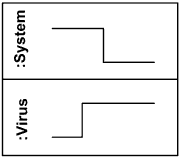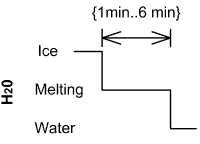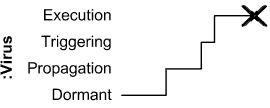UML Timing Diagrams Reference
| Notation | Description |
|---|---|
| Lifeline | |
 Lifelines representing instances of System and Virus. |
Lifeline is a named element which represents an individual participant in the interaction. While parts and structural features may have multiplicity greater than 1, lifelines represent only one interacting entity. See lifeline from sequence diagrams for details. Lifeline on the timing diagrams is represented by the name of classifier or the instance it represents. It could be placed inside diagram frame or a “swimlane”. |
| State or Condition Timeline | |
 Timeline shows Virus changing its state between Dormant, Propagation, Triggering and Execution state. |
Timing diagram could show states of the participating classifier or attribute, or some testable conditions, such as a discrete or enumerable value of an attribute. UML also allows the state/condition dimension be continuous. It could be used in scenarios where entities undergo continuous state changes, such as temperature or density. |
| Duration Constraint | |
 Ice should melt into water in 1 to 6 minutes |
Duration constraint is an interval constraint that refers to a duration interval. The duration interval is duration used to determine whether the constraint is satisfied. Duration constraint is shown as some graphical association between a duration interval and the constructs that it constrains. |
| Time Constraint | |
 Person should wake up between 5:40 am and 6 am |
Time constraint is an interval constraint that refers to a time interval. The time interval is time expression used to determine whether the constraint is satisfied. Time constraint is shown as graphical association between a time interval and the construct that it constrains. Typically this graphical association is a small line, e.g., between an occurrence specification and a time interval. |
| Destruction Occurrence | |
 Virus lifeline is terminated |
Destruction occurrence is a message occurrence which represents the destruction of the instance described by the lifeline. It may result in the subsequent destruction of other objects that this object owns by composition. No other occurrence may appear after the destruction event on a given lifeline. Complete UML name of the occurrence is destruction occurrence specification. Until UML 2.4 it was called destruction event, and earlier - stop. The destruction event is depicted by a cross in the form of an X at the end of a timeline. |

